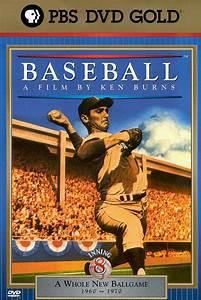
The Eighth Inning of Baseball: A Film By Ken Burns brings us into the 1960s. In this decade of the American Pastime, we find that it is being recognized less and less as such. Football has risen to prominence, and a lot of folks come to argue that football, not baseball, has now become the true national game. Additionally, the sixties were quite a stormy and unstable period in American history, filled with race riots, activism, anti-war protests, hippies, and Woodstock.
The game of baseball also finds itself experiencing some changes. In 1961, Babe Ruth’s single season home run record is threatened, then broken, by a man who is far from being a fan favorite. Roger Maris is described as moody and sullen, avoids talking to the press, and starts losing his hair as a result of the pressure he is under as he inadvertently finds himself chasing Ruth’s record.
Pitching sees a rise in dominance as the decade progresses, thanks to commissioner Ford Frick’s commandment that the strike zone be expanded to counter the explosion of home runs. Sandy Koufax and Bob Gibson are among those who rise to preeminence from their positions on the mound. As pitching becomes the ruling force in the game, there comes a decline in home runs being hit. This, in turn, contributes to the decline in fan interest in the game.
This time period also sees changes as far as the growth of the league. The success and profitability of the San Francisco Giants and the Los Angeles Dodgers in the west brings the league to consider other ways in which to spread the game throughout the country. Four new teams were added to Major League Baseball. We see the birth of the California Angels, the Washington Senators became the Minnesota Twins, then a newer Senators team moved to Arlington and became the Texas Rangers. The New York Mets and the Houston Colt .45s (later the Astros) also joined the National League. The Braves would move from Milwaukee to Atlanta and the Athletics moved to Oakland. After just one season, the Seattle Pilots left for Milwaukee and became the Brewers, and towards the end of the decade the Royals were established in Kansas City and the Expos in Montreal. (I’m sure I must be missing one or more others here, and for that, I apologize.)
At the beginning of the decade, Ebbets Field met its fate with a wrecking ball painted to resemble a baseball. Jackie Robinson, who had once played at Ebbets, now worked and fought for civil rights, and Branch Rickey, who was the force behind integration in Major League Baseball, passed away in 1965. The Polo Grounds became the home of the New York Metropolitans, led by the one and only Casey Stengel, now getting along in years. Suffices to say, the Mets weren’t very good in those early years. Eventually, Stengel would retire from baseball. After that, the same wrecking ball that took out Ebbets Field would also bring down the Polo Grounds. The Mets moved into Shea Stadium, and by the end of the decade transformed into the “Miracle Mets,” winning the 1969 World Series.
In this inning, we meet Pete Rose and see bits about Ernie Banks, Frank Robinson, Carl Yastrzemski, Whitey Ford, Roberto Clemente, and many, many others. Sandy Koufax seemingly retires almost as quickly as he broke into the league and became the youngest player ever inducted into the Hall of Fame. In Baltimore, Earl Weaver became manager of the Orioles. One of the greatest managers of all time, the Orioles became the dynasty of the decade under Weaver.
In this decade, we also meet Marvin Miller. Miller became the Executive Director of the Major League Baseball Players Association in 1966. The players loved having Miller speaking on their behalf, but baseball owners, unsurprisingly, hated having Miller around. He was a man who Red Barber would call “one of the two or three most important men in baseball history.”
By the end of the disc, we learn about Curt Flood’s battle against the reserve clause, which at this point is only just beginning. Flood learned that he was to be traded from St. Louis to Philadelphia, and in the face of the racism he knew he would face in Philadelphia, he decided to oppose the trade. This flew in the face of the entire history of baseball business.
I think my favorite feature of this disc comes in all the arguments defending baseball. In spite of George Carlin’s comedy routine that makes baseball seem like a slow, sissy sport, baseball continues to be referred to as America’s National Pastime for good reason. Sure, football is faster and perhaps more suitable to the 30-second attention span that now dominates our culture (though, more recently, football also seems to be declining in popularity). But baseball’s place in the American psyche runs deep, and in a lot of ways, it is the very nature of its leisurely pace that makes it so appealing.




